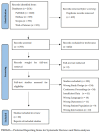Inconsistent Methods Used to Set Airway Pressure Release Ventilation in Acute Respiratory Distress Syndrome: A Systematic Review and Meta-Regression Analysis
- PMID: 38731219
- PMCID: PMC11084500
- DOI: 10.3390/jcm13092690
Inconsistent Methods Used to Set Airway Pressure Release Ventilation in Acute Respiratory Distress Syndrome: A Systematic Review and Meta-Regression Analysis
Abstract
Airway pressure release ventilation (APRV) is a protective mechanical ventilation mode for patients with acute respiratory distress syndrome (ARDS) that theoretically may reduce ventilator-induced lung injury (VILI) and ARDS-related mortality. However, there is no standard method to set and adjust the APRV mode shown to be optimal. Therefore, we performed a meta-regression analysis to evaluate how the four individual APRV settings impacted the outcome in these patients. Methods: Studies investigating the use of the APRV mode for ARDS patients were searched from electronic databases. We tested individual settings, including (1) high airway pressure (PHigh); (2) low airway pressure (PLow); (3) time at high airway pressure (THigh); and (4) time at low pressure (TLow) for association with PaO2/FiO2 ratio and ICU length of stay. Results: There was no significant difference in PaO2/FiO2 ratio between the groups in any of the four settings (PHigh difference -12.0 [95% CI -100.4, 86.4]; PLow difference 54.3 [95% CI -52.6, 161.1]; TLow difference -27.19 [95% CI -127.0, 72.6]; THigh difference -51.4 [95% CI -170.3, 67.5]). There was high heterogeneity across all parameters (PhHgh I2 = 99.46%, PLow I2 = 99.16%, TLow I2 = 99.31%, THigh I2 = 99.29%). Conclusions: None of the four individual APRV settings independently were associated with differences in outcome. A holistic approach, analyzing all settings in combination, may improve APRV efficacy since it is known that small differences in ventilator settings can significantly alter mortality. Future clinical trials should set and adjust APRV based on the best current scientific evidence available.
Keywords: APRV; ARDS; VILI.
Conflict of interest statement
G.F.N. has received honoraria and/or travel reimbursement at event(s) sponsored by Dräger Medical Systems, Inc., outside of the published work. G.F.N. has lectured for Intensive Care On-line Network, Inc. (ICON). N.M.H. has an Unrestricted Educational Grant from Dräger Medical Systems, Inc. N.M.H. is the founder of ICON. N.M.H. holds patents on a method of initiating, managing, and/or weaning airway pressure release ventilation, as well as controlling a ventilator in accordance with the same.
Figures





References
-
- Bellani G., Laffey J.G., Pham T., Fan E., Brochard L., Esteban A., Gattinoni L., Van Haren F., Larsson A., McAuley D.F., et al. Epidemiology, Patterns of Care, and Mortality for Patients with Acute Respiratory Distress Syndrome in Intensive Care Units in 50 Countries. JAMA. 2016;315:788–800. doi: 10.1001/jama.2016.0291. - DOI - PubMed
Publication types
Grants and funding
LinkOut - more resources
Full Text Sources

